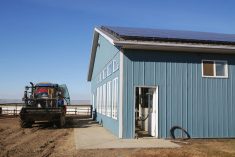AgriStability is a federal-provincial-territorial income support program designed to help Canadian farmers manage large declines in their farming income caused by production losses, rising input costs or market downturns.
It provides financial assistance when a producer’s margin (the difference between allowable income and allowable expenses) falls below 70 per cent of their historical reference margin.
By offering a stabilizing layer of support, AgriStability plays a key role in helping farmers maintain financial viability during challenging periods. The program is voluntary, and participants must enroll annually to access benefits.
Read Also

Know what costs are involved in keeping crops in the bin
When you’re looking at full bins and rising calf prices, the human reflex is to hold on and hope for more. That’s not a plan. It’s a bet. Storage has a price tag.
As of August 2025, western Canadian farmers enrolled in the AgriStability program are benefiting from key enhancements aimed at improving income support and risk management.
These changes have been implemented to better address the challenges producers face due to extreme weather events, market volatility and international trade disruptions, particularly in provinces such as Saskatchewan, Alberta and British Columbia.
One of the most significant updates to the AgriStability program for the 2025 program year is the increase in the compensation rate.
Previously set at 80 per cent, the rate has been raised to 90 per cent, meaning that eligible participants will now receive 90 cents for every dollar of margin decline beyond the coverage threshold.
This adjustment offers producers a greater financial buffer when they experience substantial losses due to lower revenues or increased production costs.
Another major improvement is the doubling of the program’s maximum payment cap.
For 2025, producers can now receive up to $6 million in support through AgriStability, up from the previous $3 million cap.
This change is particularly beneficial for large-scale operations that typically have higher exposure to risk and more significant potential losses during disruptions such as droughts, feed shortages or reduced export demand.
To address the immediate financial needs of producers, the program continues to offer interim and targeted advance payments.
These allow farmers to access up to 75 per cent of their estimated benefit ahead of the final claim settlement, helping to improve cash flow during critical periods.
Targeted advances are also made available in specific cases where sectors or regions are severely impacted by external factors such as trade barriers or extreme weather events.
Looking ahead, further improvements are planned for the 2026 program year, particularly for livestock producers.
These changes include updates to the way feed inventory is valued —shifting the focus to the value of feed held for on-farm use rather than its market price.
This aims to more accurately reflect the financial position of livestock operations, especially during dry conditions when feed is scarce.
Additionally, there are proposed adjustments to allow the inclusion of grazing on rented land as an eligible expense under the program. These anticipated changes reflect the government’s response to longstanding producer feedback, especially from livestock sectors in Saskatchewan and Alberta.
At the provincial level, all three western provinces are currently participating in the 2025 enhancements.
Saskatchewan, through the Saskatchewan Crop Insurance Corp., and British Columbia, through its joint federal-provincial administration, have confirmed full implementation of the increased compensation rate and payment cap.
In Alberta, the program is administered by Agriculture Financial Services Corp., and farmers in the province are eligible for the national enhancements.
In Manitoba, AgriStability is administered by Manitoba Agricultural Services Corp., which has also confirmed the adoption of the 2025 enhancements, ensuring that producers across the province can access the improved compensation rate and higher payment cap.
Although the enrolment deadline for the 2025 AgriStability program has passed (July 31, 2025), producers already enrolled should ensure their financial and production records are updated and submitted on time to receive maximum benefit.
With a challenging agricultural landscape characterized by ongoing climatic pressures, rising input costs and global trade uncertainties, these program changes provide critical support to stabilize farm income and sustain agricultural productivity in Western Canada.
Colin Miller is a chartered accountant and partner with KPMG’s tax practice in Lethbridge. Contact: colinmiller@kpmg.ca. He would like to thank Karrie Geremia and Jewel Sunny of KPMG for their assistance with writing this article.















